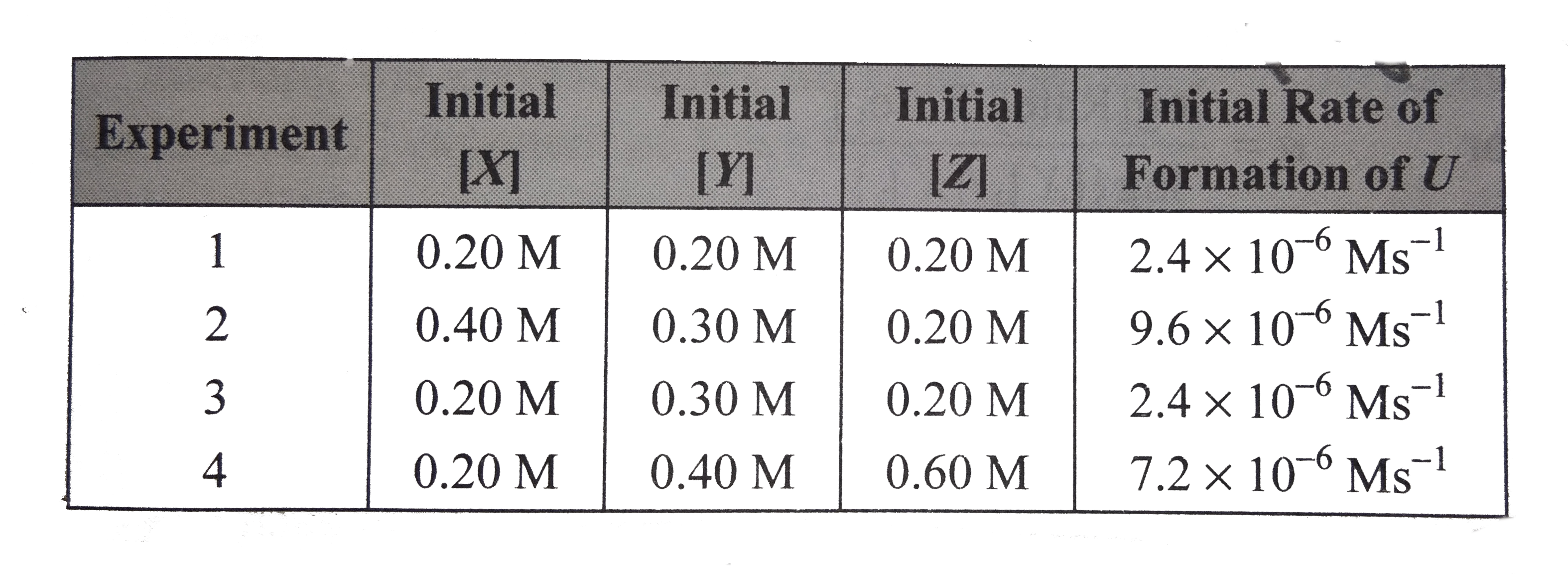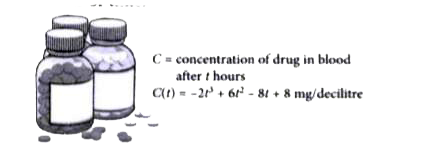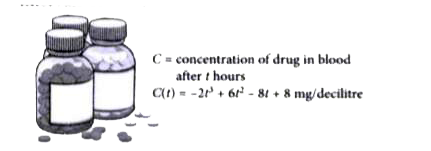A studend gets fingerprints on a cuvette before using it to determine the concentration of a coloured species using its known extinction coefficient. What is the effect on the absorbance and reported concentration ?
AbsorbanceReported concentrationIncreasedtoo law
AbsorbanceReported concentrationIncreasedtoo high
AbsorbanceReported concentrationdecreasedtoo low
AbsorbanceReported concentrationdecreasedtoo high
The correct Answer is:b
Topper's Solved these Questions
Similar Questions
Method of intial rates: Given the following data, determine the rate law expression and the value of the rate constant for the reaction. 2X+Y+Z→U+V

Strategy: The rate law is of the from
Rate=k[X]a[Y]b[Z]c
We must evaluate a,b,c, and k by using the reasoning outlined earlier. Thus, to determine order with respect to X, we must select those experiments in which concentration of X changes but the concentrations of Y and Z are kept onstant and so on. Note that the coefficient of U in the balenced equation is 1, so the rate of reaction is equal to the rate of formation of U.
View SolutionRead the given passage and answer the questions that follow :
In adsorption, the substance is concentrated only at the surface and does not penetrate through the surface to the bulk of the adsorbent, while in absorption, the substance is uniformly distributed throughout the bulk of the solid. For example, when a chalk stick is dipped in ink, the surface retains the colour of the ink due to adsorption of coloured molecules while the solvent of the ink goes deeper into the stick due to absorption. On breaking the chalk stick, it is found to be white from inside. A distinction can be made between absorption and adsorption by taking an example of water vapour. Water vapours are absorbed by anhydrous calcium chloride but adsorbed by silica gel. In other words, in adsorption the concentration of the adsorbate increases only at the surface of the adsorbent, while in adsorption the concentration is uniform throughout the bulk of the solid.
What is the term used when both adsorption and absorption occur ?
View Solution
Knowledge Check
The rate of a reaction, which may also be called its velocity or speed, can be defined with relation to the concentration of any of the reacting substances, or to that of any product of the reaction. If the species chosen is a reactant which has a concentration c at time t the rate is - dc/dt, while the rate with reference to a product having a concentration x at time t is dx/dt. Any concentration units may be used for expressing the rate, thus, if moles per liter are employed for concentration and seconds for the time, the units for the rate are moles liter−1sec−1. For gas reactions pressure units are sometimes used in place of concentrations, so that legitimate units for the rate would be (mm. Hg) sec−1 and atm. sec−1
The order of a reaction concerns the dependence of the rate upon the concentrations of reacting substances, thus, if the rate is found experimentally to be proportional to the αth power of the concentration of one of the reactants A, to the βth power of the concentration of a second reactant B, and so forth, via.,
rate kCαACβB (1)
the over-all order of the reaction is simply
n=α+β+ ---------(2)
Such a reaction is said to be of the αth order with respect to the substance A, the βth order with respect to B and so on...
(Laidler, K. J., & Glasstone, S. (1948). Rate, order and molecularity in chemical kinetics. Journal of Chemical Education, 25(7), 383.)
In the following questions, a statement of assertion followed by a statement of reason is given. Choose the correct answer out of the following choices on the basis of the above passage.
Assertion: Rate of reaction is a measure of change in concentration of reactant with respect to time.
Reason: Rate of reaction is a measure of change in concentration of product with respect to time.AAssertion and reason both are correct statements and reason is correct explanation for assertion.BAssertion and reason both are correct statements but reason is not correct explanation for assertion.CAssertion is correct statement but reason is wrong statement.DAssertion is wrong statement but reason is correct statement.The rate of a reaction, which may also be called its velocity or speed, can be defined with relation to the concentration of any of the reacting substances, or to that of any product of the reaction. If the species chosen is a reactant which has a concentration c at time t the rate is - dc/dt, while the rate with reference to a product having a concentration x at time t is dx/dt. Any concentration units may be used for expressing the rate, thus, if moles per liter are employed for concentration and seconds for the time, the units for the rate are moles liter−1sec−1. For gas reactions pressure units are sometimes used in place of concentrations, so that legitimate units for the rate would be (mm. Hg) sec−1 and atm. sec−1
The order of a reaction concerns the dependence of the rate upon the concentrations of reacting substances, thus, if the rate is found experimentally to be proportional to the αth power of the concentration of one of the reactants A, to the βth power of the concentration of a second reactant B, and so forth, via.,
rate kCαACβB (1)
the over-all order of the reaction is simply
n=α+β+ ---------(2)
Such a reaction is said to be of the αth order with respect to the substance A, the βth order with respect to B and so on...
(Laidler, K. J., & Glasstone, S. (1948). Rate, order and molecularity in chemical kinetics. Journal of Chemical Education, 25(7), 383.)
In the following questions, a statement of assertion followed by a statement of reason is given. Choose the correct answer out of the following choices on the basis of the above passage.
Assertion: For a reaction: P+2Q→ Products, Rate =k[P]1/2[Q]1 so the order of reaction is 1.5
Reason: Order of reaction is the sum of stoichiometric coefficients of the reactants.AAssertion and reason both are correct statements and reason is correct explanation for assertion.BAssertion and reason both are correct statements but reason is not correct explanation for assertion.CAssertion is correct statement but reason is wrong statement.DAssertion is wrong statement but reason is correct statement.The rate of a reaction, which may also be called its velocity or speed, can be defined with relation to the concentration of any of the reacting substances, or to that of any product of the reaction. If the species chosen is a reactant which has a concentration c at time t the rate is - dc/dt, while the rate with reference to a product having a concentration x at time t is dx/dt. Any concentration units may be used for expressing the rate, thus, if moles per liter are employed for concentration and seconds for the time, the units for the rate are moles liter−1sec−1. For gas reactions pressure units are sometimes used in place of concentrations, so that legitimate units for the rate would be (mm. Hg) sec−1 and atm. sec−1
The order of a reaction concerns the dependence of the rate upon the concentrations of reacting substances, thus, if the rate is found experimentally to be proportional to the αth power of the concentration of one of the reactants A, to the βth power of the concentration of a second reactant B, and so forth, via.,
rate kCαACβB (1)
the over-all order of the reaction is simply
n=α+β+ ---------(2)
Such a reaction is said to be of the αth order with respect to the substance A, the βth order with respect to B and so on...
(Laidler, K. J., & Glasstone, S. (1948). Rate, order and molecularity in chemical kinetics. Journal of Chemical Education, 25(7), 383.)
In the following questions, a statement of assertion followed by a statement of reason is given. Choose the correct answer out of the following choices on the basis of the above passage.
Assertion: The unit of k is independent of order of reaction.
Reason: The unit of k is moles L−1s−1.AAssertion and reason both are correct statements and reason is correct explanation for assertion.BAssertion and reason both are correct statements but reason is not correct explanation for assertion.CAssertion is correct statement but reason is wrong statement.DAssertion is wrong statement but reason is correct statement.
Determine the molar solubility of MgF2 from its solubility product Ksp=4×10−9 :
View SolutionThe rate of a reaction, which may also be called its velocity or speed, can be defined with relation to the concentration of any of the reacting substances, or to that of any product of the reaction. If the species chosen is a reactant which has a concentration c at time t the rate is - dc/dt, while the rate with reference to a product having a concentration x at time t is dx/dt. Any concentration units may be used for expressing the rate, thus, if moles per liter are employed for concentration and seconds for the time, the units for the rate are moles liter−1sec−1. For gas reactions pressure units are sometimes used in place of concentrations, so that legitimate units for the rate would be (mm. Hg) sec−1 and atm. sec−1
The order of a reaction concerns the dependence of the rate upon the concentrations of reacting substances, thus, if the rate is found experimentally to be proportional to the αth power of the concentration of one of the reactants A, to the βth power of the concentration of a second reactant B, and so forth, via.,
rate kCαACβB (1)
the over-all order of the reaction is simply
n=α+β+ ---------(2)
Such a reaction is said to be of the αth order with respect to the substance A, the βth order with respect to B and so on...
(Laidler, K. J., & Glasstone, S. (1948). Rate, order and molecularity in chemical kinetics. Journal of Chemical Education, 25(7), 383.)
In the following questions, a statement of assertion followed by a statement of reason is given. Choose the correct answer out of the following choices on the basis of the above passage.
Assertion: Reactions can occur at different speeds.
Reason: Rate of reaction is also called speed of reaction.
View SolutionPolynomials are widely used in the field of medicine and pharmaceuticals like drug testing. Many drugs tested on various patients to check their effects. Likewise, the given polynomials is used to understand the concentration of a particular drug in the blood of a patient at various intervals of time .

Based on the above information , answer the following questions .
The coefficient of t in the given polynomial is
View SolutionPolynomials are widely used in the field of medicine and pharmaceuticals like drug testing. Many drugs tested on various patients to check their effects. Likewise, the given polynomials is used to understand the concentration of a particular drug in the blood of a patient at various intervals of time .

Based on the above information , answer the following questions .
What is the degree of the given polynomial ?
View SolutionPolynomials are widely used in the field of medicine and pharmaceuticals like drug testing. Many drugs tested on various patients to check their effects. Likewise, the given polynomials is used to understand the concentration of a particular drug in the blood of a patient at various intervals of time .

Based on the above information , answer the following questions .
What is the value of the polynomial if the value of the variable is 0 ?
View Solution
